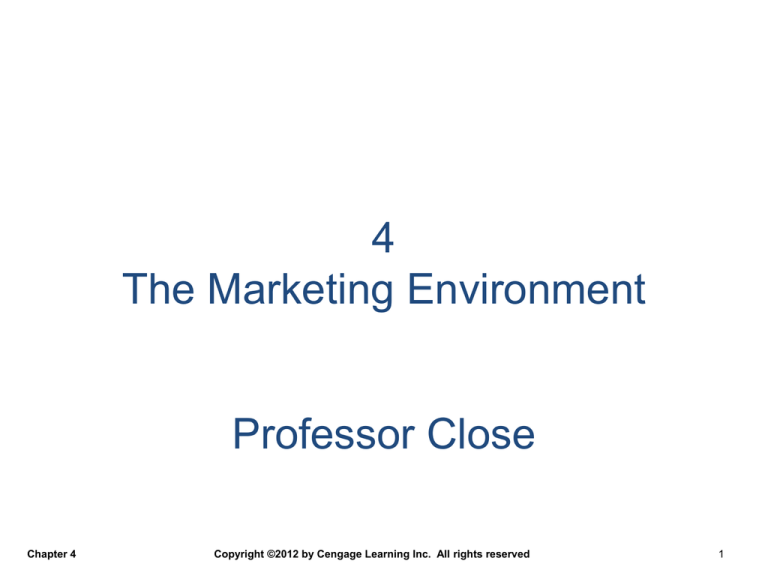
4
The Marketing Environment
Professor Close
Chapter 4
Copyright ©2012 by Cengage Learning Inc. All rights reserved
1
Learning Outcomes
LO 1 Discuss the external environment of marketing,
and explain how it affects a firm
LO 2 Describe the social factors that affect marketing
LO 3 Explain the importance to marketing managers
of current demographic trends
LO 4 Explain the importance to marketing managers
of growing ethnic markets
Chapter 4
Copyright ©2012 by Cengage Learning Inc. All rights reserved
2
Learning Outcomes
LO 5 Identify consumer and marketer reactions to
the state of the economy
LO 6 Identify the impact of technology on a firm
LO 7 Discuss the political and legal environment
of marketing
LO 8 Explain the basics of foreign and domestic
competition
Chapter 4
Copyright ©2012 by Cengage Learning Inc. All rights reserved
3
The External
Marketing Environment
Discuss the external
environment of marketing,
and explain how it affects a
firm
Chapter 4
Copyright ©2012 by Cengage Learning Inc. All rights reserved
4
Target Market
A defined group most likely to buy a product
• Changes as consumers age
• External elements change consumers’
desires
Chapter 4
Copyright ©2012 by Cengage Learning Inc. All rights reserved
5
The External Environment
• Unless marketing managers understand the
external environment, the firm cannot
intelligently plan for the future.
Environmental Management
is…
when a company implements strategies
that attempt to shape the external
environment within which it operates.
Chapter 4
Copyright ©2012 by Cengage Learning Inc. All rights reserved
6
Social Factors
Describe the social factors
that affect marketing
Chapter 4
Copyright ©2012 by Cengage Learning Inc. All rights reserved
7
Social Factors
Attitudes
Values
Lifestyle
Chapter 4
Copyright ©2012 by Cengage Learning Inc. All rights reserved
8
Social Factors
Social Factors Influence:
Products purchased
Prices paid for products
Effectiveness of promotions
How, where, and when people purchase
Chapter 4
Copyright ©2012 by Cengage Learning Inc. All rights reserved
9
American Values
Core American
Values
Emerging Trends
Self-Sufficiency
Getting off the grid
Upward Mobility
Meaningful green
Work Ethic
EcoTechMed
Conformity
Chapter 4
Copyright ©2012 by Cengage Learning Inc. All rights reserved
10
The Influence of
Values on Buying Habits
Ranked Characteristics of Product Quality
Reliability
Durability
Easy maintenance
Ease of use
Trusted brand name
Low price
Chapter 4
Copyright ©2012 by Cengage Learning Inc. All rights reserved
11
Component Lifestyles
The practice of choosing goods and
services that meet one’s diverse needs
and interests rather than conforming to
a single, traditional lifestyle.
Today’s consumers want multifunctional products
•No longer defined only by occupation
Chapter 4
Copyright ©2012 by Cengage Learning Inc. All rights reserved
12
Role of Families and
Working Women
• Growth of dual-income families results in
increased purchasing power
• Approximately 59 percent of work-age
females are in the workforce
• Working wives bring in 45 percent of the
total family earnings.
• The phenomenon of working women has
probably had a greater effect on marketing
than any other social change.
Chapter 4
Copyright ©2012 by Cengage Learning Inc. All rights reserved
13
There Is Never Enough Time
• It is estimated that over 80 percent of the
working population is worried about
having too little time.
• About 40 percent of American adults get
less than 7 hours of sleep on weekdays.
• About 74 percent of working adults
engage in multitasking.
Chapter 4
Copyright ©2012 by Cengage Learning Inc. All rights reserved
14
Demographic Factors
Explain the importance
to marketing managers of
current demographic trends
Chapter 4
Copyright ©2012 by Cengage Learning Inc. All rights reserved
15
Demographic Factors
People are the basis for any market
• Demographic characteristics relate to buyer
behavior
• Demographic cohorts have their own
needs, values, and consumption patterns.
Chapter 4
Copyright ©2012 by Cengage Learning Inc. All rights reserved
16
Tweens
Pre- and early adolescents, age 8 to 12
Population of 20 million
Directly spend about $50 billion annually
Parents spend $150 billion on tweens
annually
View TV ads as “just advertising”
Chapter 4
Copyright ©2012 by Cengage Learning Inc. All rights reserved
17
Teens
Population of about 25 million
Spend approximately 72 hours per week
tuned in electronically
View shopping as a social sport
58 percent shop online
Chapter 4
Copyright ©2012 by Cengage Learning Inc. All rights reserved
18
Generation Y
Born between 1979 and 1994
Surpassed population of baby boomers in 2010
Two Stages: 1) Those born in 1994 fit closer to
the Teen cohort. 2) Those born in 1979 have
established careers and started families.
Purchasing power of $200 billion annually
Researchers have found Gen Yers to be:
–
–
–
–
Chapter 4
Inquisitive
Opinionated
Diverse
Time managers
Quick shoppers
Want fulfillment
Multitaskers
Environmentally aware
Copyright ©2012 by Cengage Learning Inc. All rights reserved
19
Generation X
Born between 1965 and 1978
Population of 40 million
Independent, resilient, adaptable,
cautious, and skeptical
71 percent have children under age 18
Home ownership is an important goal
Avid buyers of the latest clothes,
technology, and recreational products
Chapter 4
Copyright ©2012 by Cengage Learning Inc. All rights reserved
20
Baby Boomers
Born between 1946 and 1964
Population of 75 million
Working longer to compensate for economic
downturn, which affected retirement savings
The market of services directed at seniors is one of
the fastest growing business markets
Chapter 4
Copyright ©2012 by Cengage Learning Inc. All rights reserved
21
Growing Ethnic Markets
Explain the importance to
marketing managers of
growing ethnic markets
Chapter 4
Copyright ©2012 by Cengage Learning Inc. All rights reserved
22
Growing Ethnic Markets
Estimated purchasing power of ethnic
markets in 2013:
–
–
–
Chapter 4
Hispanics: $1.4
trillion
African Americans: $1.2 billion
Asian Americans: $752 billion
The minority population of the United States
in 2011 reached 110 million.
Companies are recognizing that diversity
can result in bottom-line benefits.
Copyright ©2012 by Cengage Learning Inc. All rights reserved
23
Marketing to
Hispanic Americans
The Hispanic population’s diversity creates
challenges for targeting this market.
Hispanics tend to be brand loyal, but are not
aware of many mainstream U.S. brands.
68 percent of U.S. Hispanics have home
Internet access.
Chapter 4
Copyright ©2012 by Cengage Learning Inc. All rights reserved
24
Marketing to
African Americans
47 percent are between 18 and 49
years
More firms are creating products
for the African American market.
Promotional dollars and media
choices directed toward African
Americans continue to increase.
Chapter 4
Copyright ©2012 by Cengage Learning Inc. All rights reserved
25
Marketing to
Asian Americans
Chapter 4
Younger, better educated, and have highest
average income of all groups
Early adopters of latest digital gadgets.
Cultural diversity within the Asian American
market complicates promotional efforts.
Copyright ©2012 by Cengage Learning Inc. All rights reserved
26
Economic Factors
Identify consumer and
marketer reactions to the
state of the economy
Chapter 4
Copyright ©2012 by Cengage Learning Inc. All rights reserved
27
Economic Factors
Consumers’
Income
Purchasing
Power
Inflation
Recession
Chapter 4
Copyright ©2012 by Cengage Learning Inc. All rights reserved
28
Consumers’ Incomes
Chapter 4
•
Median U.S. household income
in 2010 was approximately
$52,000.
•
Incomes have risen at a slow pace
in recent years.
•
Education is the primary
determinant of earning potential.
Copyright ©2012 by Cengage Learning Inc. All rights reserved
29
Purchasing Power
Purchasing Power is…
a comparison of income
versus the relative cost of a
set standard of goods and
services in different
geographic areas.
Chapter 4
Copyright ©2012 by Cengage Learning Inc. All rights reserved
30
Inflation
Inflation is…
© iStockphoto.com/Valentin Mosichev
a measure of the decrease in
the value of money,
expressed as the percentage
reduction in value since the
previous year.
Chapter 4
Copyright ©2012 by Cengage Learning Inc. All rights reserved
31
Recession
Recession is…
a period of economic activity
characterized by negative
growth, which reduces
demand for goods and
services.
Chapter 4
Copyright ©2012 by Cengage Learning Inc. All rights reserved
32
Technological Factors
Identify the impact of
technology on a firm
Chapter 4
Copyright ©2012 by Cengage Learning Inc. All rights reserved
33
Research
Basic Research
Applied Research
Chapter 4
Pure research that aims to
confirm an existing theory or to
learn more about a concept
phenomenon.
An attempt to develop new or
improved products
Copyright ©2012 by Cengage Learning Inc. All rights reserved
34
Stimulating Innovation
Build scenarios
Enlist the Web
Talk to early adopters
Use marketing research
Create an innovative environment
Cater to entrepreneurs
Chapter 4
Copyright ©2012 by Cengage Learning Inc. All rights reserved
35
Political and Legal Factors
Discuss the political and
legal environment
of marketing
Chapter 4
Copyright ©2012 by Cengage Learning Inc. All rights reserved
36
Political and Legal Factors
Laws and Regulations Protect:
Chapter 4
New technology
Society
Businesses
Consumers
Copyright ©2012 by Cengage Learning Inc. All rights reserved
37
Federal Legislation
Regulate
competitive
environment
Regulate
pricing
practices
Control
false
advertising
Chapter 4
Sherman Act
Clayton Act
Federal Trade Commission Act
Celler-Kefauver Antimerger Act
Hart-Scott-Rodino Act
Foreign Corrupt Practices Act
Robinson-Patman Act
Wheeler-Lea Act
Copyright ©2012 by Cengage Learning Inc. All rights reserved
38
State Laws
•
Legislation that affects marketing varies
state by state.
•
•
Chapter 4
Oregon: limits utility advertising to 0.5 percent of
net income.
California: bans trans fats in restaurants and
bakeries.
Copyright ©2012 by Cengage Learning Inc. All rights reserved
39
Regulatory Agencies
Chapter 4
Consumer
Product Safety
Commission
Protects consumer safety in
and around their homes
Federal Trade
Commission
Prevents unfair methods of
competition in commerce
Food & Drug
Administration
Enforces safety regulations for
food and drug products
Copyright ©2012 by Cengage Learning Inc. All rights reserved
40
Bureaus of the FTC
• Reviews mergers and acquisitions
Bureau of
Competition
• Challenges anti-competitive conduct
• Promotes competition
• Provides information
• Enforces federal laws that protect
Bureau of
Consumer
Protection
Chapter 4
consumers
• Empowers consumers with information
• Communicates with consumers about
fraud and identity theft
Copyright ©2012 by Cengage Learning Inc. All rights reserved
41
Consumer Privacy
Government Actions
CAN-SPAM Act
Children’s Online Privacy Protection Act
Rule
Chapter 4
Copyright ©2012 by Cengage Learning Inc. All rights reserved
42
Competitive Factors
Explain the basics
of foreign and domestic
competition
Chapter 4
Copyright ©2012 by Cengage Learning Inc. All rights reserved
43
Competitive Factors
How many competitors?
Control
How big are competitors?
How interdependent is
the industry?
Chapter 4
Copyright ©2012 by Cengage Learning Inc. All rights reserved
44
Competitive Factors
Competition for
Market Share
and Profits
• Firms must work
harder to maintain
profits and market
share.
Chapter 4
Global
Competition
• More foreign firms
are entering U.S.
market.
• Foreign firms in
U.S. now compete
on product quality.
Copyright ©2012 by Cengage Learning Inc. All rights reserved
45
Chapter 4 Video
Method
Review the videos from chapters 2 and 3.
How do the decision Method makes reflect
the marketing environment?
Chapter 4
Copyright ©2012 by Cengage Learning Inc. All rights reserved
46








